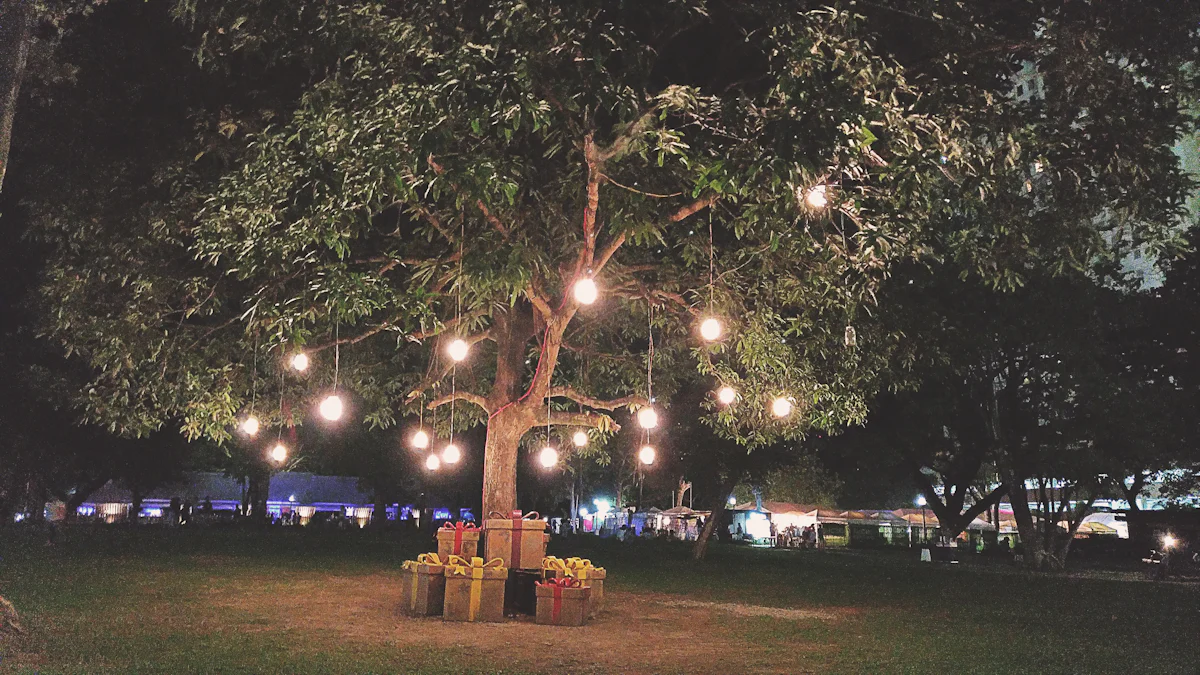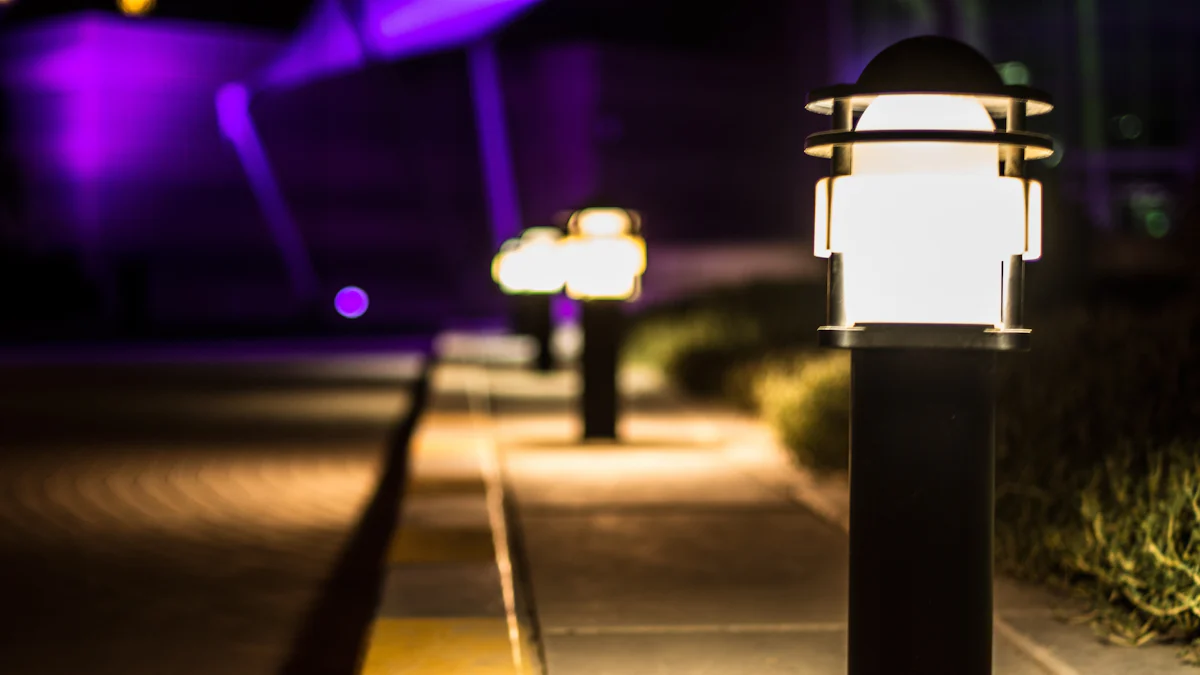
Proper garden lighting enhances the beauty and safety of outdoor spaces. LED solar lamps offer an energy-efficient and environmentally friendly solution. These lamps harness the sun’s renewable energy, reducing carbon emissions and saving on energy costs. Solar lighting can save about 20% of the original cost compared to traditional grid-tie systems. With just an initial investment, solar lamps provide free, renewable energy for years. Discover how to choose the best LED solar lamp for your garden.
Understanding LED Solar Lamps
What are LED Solar Lamps?
LED solar lamps combine light-emitting diodes (LEDs) with solar technology to provide efficient outdoor lighting.
Basic components
LED solar lamps consist of several key components:
- Solar panels: Capture sunlight and convert it into electrical energy.
- Rechargeable batteries: Store the converted energy for use during nighttime.
- LED bulbs: Provide bright, energy-efficient lighting.
- Charge controllers: Regulate the flow of electricity to prevent overcharging.
- Sensors: Detect ambient light levels to automatically turn the lamp on or off.
How they work
LED solar lamps operate by harnessing sunlight. During the day, solar panels absorb sunlight and convert it into electrical energy. This energy gets stored in rechargeable batteries. When darkness falls, sensors detect the low light levels and activate the LED bulbs, providing illumination.
Benefits of LED Solar Lamps
Energy efficiency
LED solar lamps are highly energy-efficient. LEDs consume less power compared to traditional incandescent bulbs. Solar panels generate electricity from sunlight, eliminating the need for external power sources. This combination results in significant energy savings.
Environmental impact
LED solar lamps have a positive environmental impact. Solar energy is renewable and reduces reliance on fossil fuels. Using solar lamps decreases carbon emissions, contributing to a cleaner environment. The long lifespan of LEDs also means fewer replacements and less waste.
Cost savings
LED solar lamps offer substantial cost savings. The initial investment may be higher than traditional lights, but the long-term benefits outweigh the costs. Solar lamps eliminate electricity bills associated with garden lighting. Maintenance costs are minimal due to the durability and longevity of LEDs and solar components.
Key Features to Look For in LED Solar Lamps

Brightness and Lumens
Measuring brightness
Brightness plays a crucial role in selecting the right LED solar lamp. Lumens measure the total amount of visible light emitted by a source. Higher lumens indicate brighter light. To measure the brightness of an LED solar lamp, check the lumen rating provided by the manufacturer. This rating helps determine the effectiveness of the lamp in illuminating your garden.
Recommended lumens for garden areas
Different garden areas require varying levels of brightness. Pathways and walkways need around 100-200 lumens for safe navigation. Garden beds and decorative areas benefit from 50-100 lumens to highlight plants and features. For security purposes, choose LED solar lamps with 700-1300 lumens to ensure adequate illumination.
Battery Life and Charging Time
Types of batteries
LED solar lamps use different types of batteries. Common options include Nickel-Metal Hydride (NiMH), Lithium-Ion (Li-Ion), and Lead-Acid batteries. NiMH batteries offer moderate capacity and lifespan. Li-Ion batteries provide higher capacity and longer lifespan. Lead-Acid batteries are less common but offer high capacity and durability.
Average charging times
Charging time varies based on battery type and solar panel efficiency. On average, LED solar lamps take 6-8 hours of direct sunlight to fully charge. Ensure the solar panel receives adequate sunlight to maximize charging efficiency. Proper placement of the solar panel ensures optimal performance of the LED solar lamp.
Durability and Weather Resistance
Materials used
Durability is essential for outdoor lighting. High-quality LED solar lamps use materials like stainless steel, aluminum, and durable plastics. These materials withstand harsh weather conditions and resist corrosion. Investing in durable materials ensures the longevity of your LED solar lamp.
IP ratings explained
Ingress Protection (IP) ratings indicate the level of protection against dust and water. An IP65 rating means the LED solar lamp is dust-tight and protected against water jets. For garden use, choose lamps with at least an IP44 rating. Higher IP ratings offer better protection, ensuring the lamp performs well in various weather conditions.
Design and Aesthetics
Styles available
LED solar lamps come in various styles to suit different garden themes. Some popular styles include:
- Pathway lights: These lights line walkways, providing guidance and safety. Pathway lights often feature sleek, modern designs or classic lantern shapes.
- Spotlights: Spotlights highlight specific garden features like statues, trees, or flower beds. Adjustable heads allow for precise lighting angles.
- String lights: String lights create a whimsical atmosphere. These lights drape over bushes, fences, or pergolas, adding charm to outdoor spaces.
- Decorative lights: Decorative lights come in unique shapes and designs. Options include lanterns, globes, and even animal figures.
Each style offers distinct benefits. Choose based on the desired effect and garden layout.
Matching garden decor
Matching LED solar lamps with garden decor enhances the overall aesthetic. Consider the following tips:
- Color coordination: Select lamp colors that complement existing garden elements. For example, bronze or copper lamps blend well with earthy tones. Stainless steel suits modern gardens with metallic accents.
- Material harmony: Match lamp materials with garden furniture or structures. Wooden lamps pair well with rustic settings. Metal lamps fit contemporary designs.
- Theme consistency: Ensure the lamp style aligns with the garden theme. For instance, lantern-style lamps suit a traditional garden. Sleek, minimalist lamps enhance a modern garden.
Properly chosen LED solar lamps not only illuminate but also elevate the garden’s beauty.
Installation Tips for LED Solar Lamps

Choosing the Right Location
Sunlight exposure
Select a spot with maximum sunlight exposure. LED solar lamps need direct sunlight to charge efficiently. Place the solar panel in an area that receives at least 6-8 hours of sunlight daily. Avoid shaded spots under trees or structures.
Avoiding obstructions
Ensure no objects block the solar panel. Obstructions like branches or buildings reduce charging efficiency. Position the lamp where it can absorb sunlight without interference. Clear any debris or dirt from the panel regularly.
Step-by-Step Installation Guide
Tools needed
Gather necessary tools before starting the installation. Common tools include:
- Screwdriver
- Drill
- Level
- Tape measure
Having these tools ready ensures a smooth installation process.
Installation process
- Mark the location: Identify the spot for the LED solar lamp. Use a tape measure and level to mark the exact position.
- Prepare the surface: Clean the area where the lamp will be installed. Ensure the surface is flat and stable.
- Install the mounting bracket: Attach the mounting bracket to the marked spot. Use a drill and screws to secure it firmly.
- Attach the lamp: Place the LED solar lamp onto the mounting bracket. Tighten the screws to hold the lamp in place.
- Adjust the angle: Adjust the angle of the solar panel for optimal sunlight exposure. Ensure the panel faces the sun directly.
- Test the lamp: Turn on the lamp to check its functionality. Ensure the lamp charges during the day and illuminates at night.
Customers often praise the brightness and charge efficiency of LED solar lamps. Proper installation maximizes these benefits, ensuring reliable performance.
Maintenance and Care for LED Solar Lamps
Proper maintenance ensures the longevity and performance of your LED solar lamp. Follow these guidelines to keep your garden lighting in top condition.
Regular Cleaning
Cleaning materials
Use soft cloths and mild soap for cleaning. Avoid abrasive materials that can scratch surfaces. A soft brush helps remove dirt from crevices.
Cleaning frequency
Clean your LED solar lamp every few months. Frequent cleaning ensures optimal light output and efficient charging. Inspect the solar panel for dirt and debris regularly.
Battery Maintenance
Checking battery health
Check the battery health periodically. Look for signs of corrosion or leakage. Use a multimeter to measure the voltage. Replace batteries showing low voltage or damage.
Replacing batteries
Replace the batteries every 1-2 years. Use compatible batteries specified by the manufacturer. Follow the instructions for safe battery replacement.
Troubleshooting Common Issues
Lamp not turning on
If the LED solar lamp does not turn on, check the solar panel for obstructions. Ensure the lamp receives adequate sunlight. Inspect the connections for any loose wires.
Reduced brightness
Reduced brightness may indicate dirty solar panels or weak batteries. Clean the solar panel thoroughly. Replace the batteries if necessary. Ensure the lamp receives sufficient sunlight during the day.
Choosing the best LED solar lamp for your garden involves understanding key features and proper maintenance. LED solar lamps offer energy efficiency, environmental benefits, and cost savings. Consider brightness, battery life, durability, and design when selecting a lamp. Proper installation and regular maintenance ensure optimal performance. Explore options and make a purchase to enhance your garden’s beauty and functionality. Illuminate your outdoor space with reliable and sustainable lighting solutions.
Post time: Jul-10-2024
